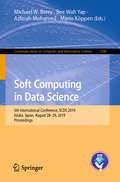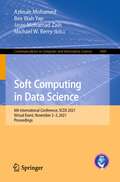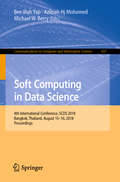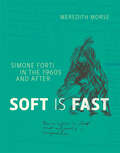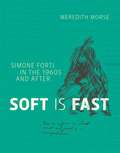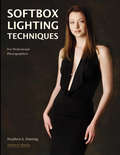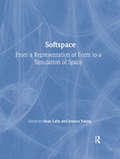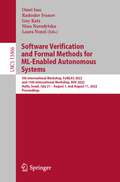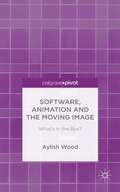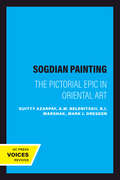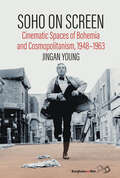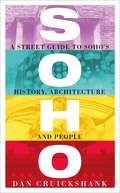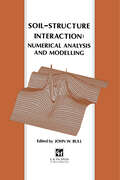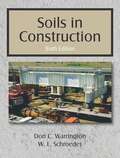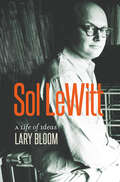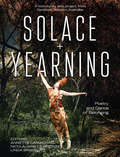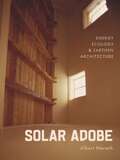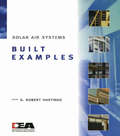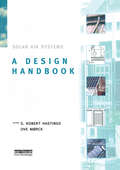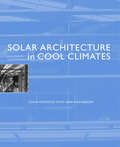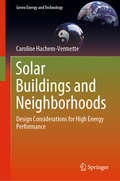- Table View
- List View
Soft Computing in Data Science: 5th International Conference, SCDS 2019, Iizuka, Japan, August 28–29, 2019, Proceedings (Communications in Computer and Information Science #1100)
by Michael W. Berry Mario Köppen Bee Wah Yap Azlinah MohamedThis book constitutes the refereed proceedings of the 5th International Conference on Soft Computing in Data Science, SCDS 2019, held in Iizuka, Japan, in August 2019. The 30 revised full papers presented were carefully reviewed and selected from 75 submissions. The papers are organized in topical sections on information and customer analytics; visual data science; machine and deep learning; big data analytics; computational and artificial intelligence; social network and media analytics.
Soft Computing in Data Science: 6th International Conference, SCDS 2021, Virtual Event, November 2–3, 2021, Proceedings (Communications in Computer and Information Science #1489)
by Michael W. Berry Bee Wah Yap Azlinah Mohamed Jasni Mohamad ZainThis book constitutes the refereed proceedings of the 6th International Conference on Soft Computing in Data Science, SCDS 2021, which was held virtually in November 2021. The 31 revised full papers presented were carefully reviewed and selected from 79 submissions. The papers are organized in topical sections on AI techniques and applications; data analytics and technologies; data mining and image processing; machine & statistical learning.
Soft Computing in Data Science: First International Conference, Scds 2015, Putrajaya, Malaysia, September 2-3, 2015, Proceedings (Communications In Computer And Information Science #545)
by Michael W. Berry Bee Wah Yap Azlinah Hj MohamedThis book constitutes the refereed proceedings of the 4th International Conference on Soft Computing in Data Science, SCDS 2018, held in Bangkok, Thailand, in August 2018.The 30 revised full papers presented were carefully reviewed and selected from 75 submissions. The papers are organized in topical sections on machine and deep learning, image processing, financial and fuzzy mathematics, optimization algorithms, data and text analytics, data visualization.
Soft Is Fast: Simone Forti in the 1960s and After
by Meredith MorseAn innovative analysis of Simone Forti's interdisciplinary art, viewing her influential 1960s “dance constructions” as negotiating the aesthetic strategies of John Cage and Anna Halprin.Simone Forti's art developed within the overlapping circles of New York City's advanced visual art, dance, and music of the early 1960s. Her “dance constructions” and related works of the 1960s were important for both visual art and dance of the era. Artists Robert Morris and Yvonne Rainer have both acknowledged her influence.Forti seems to have kept one foot inside visual art's frames of meaning and the other outside them. In Soft Is Fast, Meredith Morse adopts a new way to understand Forti's work, based in art historical analysis but drawing upon dance history and cultural studies and the history of American social thought. Morse argues that Forti introduced a form of direct encounter that departed radically from the spectatorship proposed by Minimalism, and prefigured the participatory art of recent decades.Morse shows that Forti's work negotiated John Cage's ideas of sound, score, and theater through the unique approach to movement, essentially improvisational and grounded in anatomical exploration, that she learned from performer and teacher Ann (later Anna) Halprin. Attentive to Robert Whitman's and La Monte Young's responses to Cage, Forti reshaped Cage's concepts into models that could accommodate Halprin's charged spaces and imagined, interpenetrative understanding of other bodies.Morse considers Forti's use of sound and her affective use of materials as central to her work; examines Forti's text pieces, little discussed in art historical literature; analyzes Huddle, considered one of Forti's signature works; and explicates Forti's later improvisational practice. Forti has been relatively overlooked by art historians, perhaps because of her work's central concern with modes of feeling and embodiment, unlike other art of the 1960s, which was characterized by strategies of depersonalization and affectlessness. Soft Is Fast corrects this critical oversight.
Soft is Fast: Simone Forti in the 1960s and After
by Meredith MorseSimone Forti's art developed within the overlapping circles of New York City's advanced visual art, dance, and music of the early 1960s. Her "dance constructions" and related works of the 1960s were important for both visual art and dance of the era. Artists Robert Morris and Yvonne Rainer have both acknowledged her influence.Forti seems to have kept one foot inside visual art's frames of meaning and the other outside them. In Soft Is Fast, Meredith Morse adopts a new way to understand Forti's work, based in art historical analysis but drawing upon dance history and cultural studies and the history of American social thought. Morse argues that Forti introduced a form of direct encounter that departed radically from the spectatorship proposed by Minimalism, and prefigured the participatory art of recent decades.Morse shows that Forti's work negotiated John Cage's ideas of sound, score, and theater through the unique approach to movement, essentially improvisational and grounded in anatomical exploration, that she learned from performer and teacher Ann (later Anna) Halprin. Attentive to Robert Whitman's and La Monte Young's responses to Cage, Forti reshaped Cage's concepts into models that could accommodate Halprin's charged spaces and imagined, interpenetrative understanding of other bodies.Morse considers Forti's use of sound and her affective use of materials as central to her work; examines Forti's text pieces, little discussed in art historical literature; analyzes Huddle, considered one of Forti's signature works; and explicates Forti's later improvisational practice. Forti has been relatively overlooked by art historians, perhaps because of her work's central concern with modes of feeling and embodiment, unlike other art of the 1960s, which was characterized by strategies of depersonalization and affectlessness. Soft Is Fast corrects this critical oversight.
Softbox Lighting Techniques: For Professional Photographers
by Stephen A. DantzigSoftboxes#151;specialized photographic lighting devices that produce a flattering and soft, low-contrast look#151;are the main focus of this resource for photographers. Professional and amateur photographers alike will be able to apply the thorough explanations on the simple, yet highly effective, light- and shadow-altering methodologies found in this guidebook to any subject matter in portrait, fashion, and editorial images. Additional chapters cover the use of softboxes in partnership with other light sources, including sunlight and various types of studio lighting treatments.
Softspace: From a Representation of Form to a Simulation of Space
by Sean Lally; Jessica YoungThis well-illustrated book unites essayists and emerging architectural practices to examine how digital tools are increasingly being used in architectural design, not only to show form, structure and geometries but also to visualize and simulate energies and material qualities such as air, gas, sound, scent and electricity. Softspace takes stock of current advancements in design and research, while drawing on historical and ideological trajectories rooted in the past fifty years. The varied contributors examine the capabilities of such 'energy matters' to act as catalysts for design innovation today. This well-presented and impressively authored title will provoke architects of all levels to consider the potential for creative and innovative design through the use of digital design tools.
Software Verification and Formal Methods for ML-Enabled Autonomous Systems: 5th International Workshop, FoMLAS 2022, and 15th International Workshop, NSV 2022, Haifa, Israel, July 31 - August 1, and August 11, 2022, Proceedings (Lecture Notes in Computer Science #13466)
by Omri Isac Radoslav Ivanov Guy Katz Nina Narodytska Laura NenziThis book constitutes the refereed proceedings of the 5th International Workshop on Software Verification and Formal Methods for ML-Enables Autonomous Systems, FoMLAS 2022, and the 15th International Workshop on Numerical Software Verification, NSV 2022, which took place in Haifa, Israel, in July/August 2022. The volume contains 8 full papers from the FoMLAS 2022 workshop and 3 full papers from the NSV 2022 workshop. The FoMLAS workshop is dedicated to the development of novel formal methods techniques to discussing on how formal methods can be used to increase predictability, explainability, and accountability of ML-enabled autonomous systems. NSV 2022 is focusing on the challenges of the verification of cyber-physical systems with machine learning components.
Software, Animation and the Moving Image: What’s in the Box?
by Aylish WoodSoftware, Animation and the Moving Image brings a unique perspective to the study of computer-generated animation by placing interviews undertaken with animators alongside an analysis of the user interface of animation software. Wood develops a novel framework for considering computer-generated images found in visual effects and animations.
Sogdian Painting: The Pictorial Epic in Oriental Art
by Guitty AzarpayThis title is part of UC Press's Voices Revived program, which commemorates University of California Press’s mission to seek out and cultivate the brightest minds and give them voice, reach, and impact. Drawing on a backlist dating to 1893, Voices Revived makes high-quality, peer-reviewed scholarship accessible once again using print-on-demand technology. This title was originally published in 1981.This title is part of UC Press's Voices Revived program, which commemorates University of California Press’s mission to seek out and cultivate the brightest minds and give them voice, reach, and impact. Drawing on a backlist dating to 1893, Voices Revived</DIV
Soho on Screen: Cinematic Spaces of Bohemia and Cosmopolitanism, 1948-1963
by Jingan YoungDespite Soho’s rich cultural history, there remains an absence of work on the depiction of the popular neighbourhood in film. Soho on Screen provides one of the first studies of Soho within postwar British cinema. Drawing upon historical, cultural and urban studies of the area, this book explores twelve films and theatrically released documentaries from a filmography of over one hundred Soho set productions. While predominantly focusing on low-budget, exploitation films which are exemplars of British and international filmmaking, Young also offers new readings of star and director biographies, from Laurence Harvey to Emeric Pressburger, and in so doing enlivens discussion on filmmaking in a time and place of intense social transformation, technological innovation and growing permissiveness.
Soho on Screen: Cinematic Spaces of Bohemia and Cosmopolitanism, 1948-1963
by Jingan YoungDespite Soho’s rich cultural history, there remains an absence of work on the depiction of the popular neighbourhood in film. Soho on Screen provides one of the first studies of Soho within post-war British cinema. Drawing upon historical, cultural and urban studies of the area, this book explores twelve films and theatrically released documentaries from a filmography of over one hundred Soho set productions. While predominantly focusing on low-budget, exploitation films which are exemplars of British and international filmmaking, Young also offers new readings of star and director biographies, from Laurence Harvey to Emeric Pressburger, and in so doing enlivens discussion on filmmaking in a time and place of intense social transformation, technological innovation and growing permissiveness.
Soho: A Street Guide to Soho's History, Architecture and People
by Dan CruickshankSoho - illicit, glamorous, sordid, louche, poverty-stricken, squalid, exhilarating. One of Britain's best-loved historians, Dan Cruickshank, grants us an intimacy with centuries of rich and varied history as he guides us around the Soho of the last five hundred years. We learn of its original aspirations towards respectability, how it became London's bohemian quarter and why it was once home to its criminal underworld. The bars, clubs, theatres and their frequenters are described with detail that evokes the heart of the district. The history of Soho is written in its surviving architecture. Cruickshank points out the streets that were the stamping grounds of criminal dynasties and directs our attention towards the homes of renowned prostitutes, revealing Georgian sexual mores and surprising visitors - amongst them eighteenth-century painter Joshua Reynolds, whose peculiar 'caprice' was simply drawing the girls. Soho has been home to characters as diverse as Mrs Goadby's girls to the Maltese mafia, and Cruikshank draws these threads together with kaleidoscopic verve. Even as he mourns some of the changes, he pays testament to the district's resilience. He observes how the common denominator over the centuries is that it has always been a destination for immigrants: from French Huguenots to the East European Jewish community and recent Chinese diaspora - and that this is the foundation of its spirit and success.
Soho: A Street Guide to Soho’s History, Architecture and People
by Dan CruickshankSoho - illicit, glamorous, sordid, louche, poverty-stricken, squalid, exhilarating. One of Britain's best-loved historians, Dan Cruickshank, grants us an intimacy with centuries of rich and varied history as he guides us around the Soho of the last five hundred years. We learn of its original aspirations towards respectability, how it became London's bohemian quarter and why it was once home to its criminal underworld. The bars, clubs, theatres and their frequenters are described with detail that evokes the heart of the district. The history of Soho is written in its surviving architecture. Cruickshank points out the streets that were the stamping grounds of criminal dynasties and directs our attention towards the homes of renowned prostitutes, revealing Georgian sexual mores and surprising visitors - amongst them eighteenth-century painter Joshua Reynolds, whose peculiar 'caprice' was simply drawing the girls. Soho has been home to characters as diverse as Mrs Goadby's girls to the Maltese mafia, and Cruikshank draws these threads together with kaleidoscopic verve. Even as he mourns some of the changes, he pays testament to the district's resilience. He observes how the common denominator over the centuries is that it has always been a destination for immigrants: from French Huguenots to the East European Jewish community and recent Chinese diaspora - and that this is the foundation of its spirit and success.
Soil-Structure Interaction: Numerical Analysis and Modelling
by John W. BullThis book describes how a number of different methods of analysis and modelling, including the boundary element method, the finite element method, and a range of classical methods, are used to answer some of the questions associated with soil-structure interaction.
Soils in Construction
by Don C. Warrington W. L. SchroederMost geotechnical books on soil mechanics or foundations focus exclusively on the needs of engineers. But the increasing complexity of the construction environment requires construction and engineering managers to know more about engineering requirements. Soils in Construction provides students in those disciplines with the necessary background to make informed decisions about soils. Every chapter of the Sixth Edition has been thoroughly updated, with all examples made even more clear and easier for students to follow. Many photos illustrate the concepts and applications of soils and geotechnical structures throughout the book. An appendix detailing lab procedures allow the book to serve those courses with a lab component while still maintaining flexibility for those without.
Soja-Kerzen: Enthüllung der besten Lieferanten für den Kerzenzubehör
by Amber RichardsHast du dich jemals gefragt, ob du wirklich erstaunliche Sojakerzen von hoher Qualität zu Hause herstellen kannst? Kerzen aus Sojawachs, die stark duften und tatsächlich richtig abbrennen? Wie sieht es mit der Fähigkeit aus, deine Freunde und Familie mit selbstgemachte Geschenke, die sie wirklich lieben, zu beeindrucken? Amber Richards stellte seit vielen Jahren ihre eigenen Sojakerzen im Glas her und betrieb mit diesen Kerzen ein Heimgeschäft. In diesem Buch werden die Techniken zur Herstellung von qualitativ hochwertigen Soja-Kerzen in Behältern klar beschrieben. Sie verrät auch ihre liebsten Kerzenlieferanten, da sie festgestellt hat, dass dies eine große Hürde für viele Personen war, die dieses Projekt durchführen wollten, und es zählte auch zu den am häufigsten gestellten Fragen. In diesem eBook geht es weniger um den geschäftlichen Aspekt der Kerzenherstellung, sondern konzentriert sich auf den kreativen "How-to"-Prozess der Herstellung dieser Kerzen in Gläsern. Informiere dich über die richtigen Techniken des Kerzenbrennens und welche Eigenschaften eine Kerzen von größter Qualität ausmacht. Das Gießen von Kerzen ist eine genussvolle und entspannende Tätigkeit. Und am Ende wird eine fertige Kerze dabei entstehen, bei der du stolz sagen kannst: „Die habe ich gemacht".
Sol LeWitt: A Life of Ideas (The\driftless Connecticut Series And Garnet Bks.)
by Lary BloomSol LeWitt (1928-2007), one of the most influential artists of the twentieth century, upended traditional practices of how art is made and marketed. A key figure in minimalism and conceptualism, he proclaimed that the work of the mind is much more important than that of the hand. For his site-specific work—wall drawings and sculpture in dozens of countries—he created the idea and basic plan and then hired young artists to install the pieces. Though typically enormous and intricate, the physical works held no value. The worth was in the pieces of paper that certified and described them. LeWitt championed and financially supported colleagues, including women artists brushed aside by the bullies of a male-dominated profession. Yet the man himself has remained an enigma, as he refused to participate in the culture of celebrity. Lary Bloom's book draws on personal recollections of LeWitt, whom he knew in the last years of the artist's life, as well as LeWitt's letters and papers and over one hundred original interviews with his friends and colleagues, including Chuck Close, Ingrid Sischy, Philip Glass, Adrian Piper, Jan Dibbets, and Carl Andre. This absorbing chronicle brings new information to our understanding of this important artist, linking the extraordinary arc of his life to his iconic work. Includes 28 illustrations.
Solace + Yearning – Poetry of Dance and Belonging: A Community Arts Project from Denmark, Western Australia
by Annette Carmichael‘Solace + Yearning’ layers landscape, poetry, eco-art and contemporary dance to create an immersive space for many voices: yearning to connect to country, grief for what is absent, and reaching towards an understanding of indigenous language and culture. “Along the edges, voices call softly, softly… the past speaking to the present.” This multi-arts collaboration explores ‘settler guilt’ and ‘solastalgia’—a sense of loss caused by environmental change—in a small rural community. The work unravels contradictory and complicated feelings about Australia’s stories, the assumed advantage of non-indigenous Australians, and yet our deep longing for the wisdom and connection intrinsic in indigenous cultures. “It is beneath the bark where stories are whispered and life rises to stitch together this river with this sky.” Performed in Denmark, Western Australia in 2012, and again as a solo performance by Annette Carmichael in 2014, these images and reflections portray a complex relationship between people and place. “Sometimes, sometimes I make the mistake of thinking that what has not been written down has been forgotten.” With gratitude to Joey Williams, Wayne Webb, Toni Webb, and Harley Coyne, who walked the trail with us and generously shared their Noongar culture and stories.
Solar Adobe: Energy, Ecology, and Earthen Architecture
by Albert NarathHow a centuries-old architectural tradition reemerged as a potential solution to the political and environmental crises of the 1970s Against the backdrop of a global energy crisis, a widespread movement embracing the use of raw earth materials for building construction emerged in the 1970s. Solar Adobe examines this new wave of architectural experimentation taking place in the United States, detailing how an ancient tradition became a point of convergence for issues of environmentalism, architecture, technology, and Indigenous resistance. Utilized for centuries by the Pueblo people of the American Southwest and by Spanish colonialists, adobe construction found renewed interest as various groups contended with the troubled legacies of modern architecture and an increasingly urgent need for sustainable design practices. In this period of critical experimentation, design networks that included architects, historians, counterculture communities, government weapons labs, and Indigenous activists all looked to adobe as a means to address pressing environmental and political issues. Albert Narath charts the unique capacities of adobe construction across a wide range of contexts, consistently troubling simple distinctions between traditional and modern technologies, high design and vernacular architecture. Drawing insightful parallels between architecture, environmentalism, and movements for Indigenous sovereignty, Solar Adobe stresses the importance of considering the history of the built environment in conjunction with architecture&’s larger impact on the natural world.
Solar Air Systems - Built Examples
by Robert HastingsThirty-five different buildings with successfully installed solar air systems are described and documented. The building types cover single family houses, apartment buildings, schools, sports halls, and industrial commercial buildings with six different configurations of solar air systems used. Each example building is described over several pages, with plans, performance details and illustrations provided. This is supplemented by a summary of the types of system used.
Solar Air Systems: A Design Handbook
by Robert HastingsActive solar systems for air heating are a straightforward yet effective way of using solar energy for space heating and tempering ventilation air. They offer some unique advantages over solar water systems, can offer improved comfort and fuller use of solar gains than passive solar systems and are a natural fit with mechanically ventilated buildings. They can be economical, with short pay-back periods and can act not only as space heating or ventilation air heating but also for water pre-heating, sunshading, electricity generation (with hybrid photovoltaic systems) and can help induce cooling. This design handbook takes architects and building engineers through the process of designing and selecting an active solar system from the six types presented, optimizing the system using nomograms and curves, and finally dimensioning the components of the system. Tips are offered regarding the construction and how to avoid problems. The book will provide essential design information for all architects, building engineers and other building design professionals and all those concerned to reduce the environmental impact of buildings.
Solar Architecture in Cool Climates
by Colin Porteous'A must-read for practitioners, teachers and others interested in or working with energy use in the built environment, including a delightful set of examples' Ann Grete Hestnes, former President of the International Solar Energy Society Solar Architecture in Cool Climates is an invaluable primer on low energy building design, combining accessible information with convincing arguments enabling new techniques to be implemented in daily practice. Approaching the topic in a thematic manner, the book provides inspiration, an understanding of key principles and technical data on the design of solar buildings in higher latitudes. The text is enlivened through direct experience of case studies from Europe and North America dealing with new-build, retrofitting and conceptual projects that outline future potential (the principles being equally applicable to equivalent southern latitude locations. The authors examine the dilution of additional costs through different strategies, the tensions between energy efficiency and environmental quality, and the proactive control of energy in building design. Promoting flexibility and opportunity to a diverse audience, including those who use, procure and finance buildings, the book aims to bring the design of 'green' solar buildings in cool climates from special interest status into the mainstream. Broader environmental issues relating to solar architecture are addressed in the final chapter, again drawing on case studies from the authors' own wide experience. Solar Architecture in Cool Climates is written for architects and other building designers, students of architecture and other professionals interested in sustainable architecture, renewable energy and engineering.
Solar Buildings and Neighborhoods: Design Considerations for High Energy Performance (Green Energy and Technology)
by Caroline Hachem-VermetteThis book presents the main principles for designing buildings and neighborhoods with increased potential to capture and utilize solar energy. It discusses practical issues in the design of the built environment and their impact on energy performance; and a range of design considerations, from building components (e.g. the building envelope) to urban planning issues (e.g. density and street layouts). In addition to design guidelines on how to increase buildings’ potential to capture solar energy, the book provides creative tips to increase the aesthetic value of solar technology integration in buildings. Helping readers plan energy-efficient buildings with innovative building envelope technologies, and to understand the impact of early-stage design considerations on the energy performance of buildings and communities, the book offers a valuable source of information for building professionals, including architects, engineers, and urban planners. It can also serve as a reference guide for academics and students of energy efficiency in buildings and urban planning.
